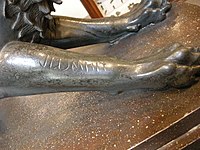Tinia
| Tinia | |
|---|---|
God of the Sky | |
 Terracotta bust of Tinia from 300–250 BCE | |
| Symbol | Thunderbolt |
| Personal information | |
| Consort | Uni |
| Children | Hercle and Menrva |
| Equivalents | |
| Greek equivalent | Zeus |
| Roman equivalent | Jupiter |
| Egyptian equivalent | Amun |
In Etruscan religion and mythology, Tinia (also Tin, Tinh, Tins or Tina) was the god of the sky and the highest god in Etruscan mythology, equivalent to the Roman Jupiter and the Greek Zeus.[1] However, a primary source from the Roman Varro states that Veltha, not Tins, was the supreme deity of the Etruscans.[2] This has led some scholars to conclude that they were assimilated, but this is speculation.[3] He was the husband of Uni and the father of Hercle. Like many other Etruscan deities, his name is gender neutral.[4]
The Etruscans had a group of nine gods who had the power of hurling thunderbolts; they were called Novensiles by the Romans.[5] Of thunderbolts there were eleven sorts, of which Tinia, wielded three.[5]
Tinia was sometimes represented as with a beard or sometimes youthful and beardless.[3] In terms of symbolism, Tinia has the thunderbolt.[3][4] Particularly, the ones of Tinia could be red or blood coloured.[6]
Like Selvans[3] and possibly Laran,[7] Tinia also protected boundaries. His name appears as the guarantor on three boundary stones with identical inscriptions found in Tunisia, originally placed there by the Etruscan colonists.[3]
Some of Tinia's possible epithets are detailed on the Piacenza Liver, a bronze model of a liver used for haruspicy. These inscriptions have been transcribed as Tin Cilens, Tin Θuf and Tinś Θne. There have been a number of suggestions as to their meaning, but the Etruscan language is poorly understood and there is no scholarly consensus for the translation.
Inscriptions[]

Tinia appears in several inscriptions, including:
- Kylix painted by Oltos (c. 500 BC):
- Itun turuce venel atelinas Tinas cliniiaras.
- This has given Venel Atelinas for the sons of Tin (ie: The Dioscuri[8])
- On the bronze Chimera of Arezzo:
- Tinscvil
- A gift to Tinia
See also[]
References[]
| Wikimedia Commons has media related to Tinia. |
- ^ de Grummond, Etruscan Myth, Sacred History and Legend, page 53
- ^ Varro, De lingua Latina V.46.
- ^ Jump up to: a b c d e The Religion of the Etruscans. University of Texas Press. 2006.
- ^ Jump up to: a b The Etruscan World. Routledge. 2013. ISBN 978-0-415-67308-2.
- ^ Jump up to: a b Dennis, George (1848). The cities and cemeteries of Etruria: Vol.I. London.
- ^ Nancy T. de Grummond, "Thunder versus Lightning in Etruria," Etruscan Studies, 2016, 19(2), 183-207.
- ^ Konstantinos I. Soueref; Ariadni Gartziou-Tatti (2019). Gods of Peace and War in the Myths of the Mediterranean People. Ioannina, Greece: Ephorate of Antiquities of Ioannina - University of Ioannina. ISBN 978-960-233-247-4.
- ^ Giuliano Bonfante and Larissa Bonfante (1983). The Etruscan language: an introduction. Manchester University Press.
- Etruscan gods
- Etruscan religion
- Sky and weather gods
- Thunder gods
- Time and fate gods
- Jovian deities
- Etruria stubs
- Deity stubs


